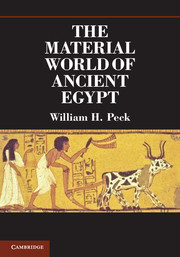Book contents
- Frontmatter
- Contents
- List of Figures
- Preface
- Acknowledgments
- Introduction
- 1 Geography and Geology
- 2 Brief Outline of Egyptian History
- 3 Study of the Material World of Ancient Egypt
- 4 Dress and Personal Adornment
- 5 Housing and Furniture
- 6 Food and Drink
- 7 Hygiene and Medicine
- 8 Containers of Clay and Stone
- 9 Tools and Weapons
- 10 Basketry, Rope, Matting
- 11 Faience and Glass
- 12 Transportation
- 13 Sport and Games
- 14 Music and Dance
- 15 Weapons and Armor
- 16 Conclusions
- Sources of Chapter Heading Quotations
- Bibliography
- Index
13 - Sport and Games
Published online by Cambridge University Press: 05 August 2013
- Frontmatter
- Contents
- List of Figures
- Preface
- Acknowledgments
- Introduction
- 1 Geography and Geology
- 2 Brief Outline of Egyptian History
- 3 Study of the Material World of Ancient Egypt
- 4 Dress and Personal Adornment
- 5 Housing and Furniture
- 6 Food and Drink
- 7 Hygiene and Medicine
- 8 Containers of Clay and Stone
- 9 Tools and Weapons
- 10 Basketry, Rope, Matting
- 11 Faience and Glass
- 12 Transportation
- 13 Sport and Games
- 14 Music and Dance
- 15 Weapons and Armor
- 16 Conclusions
- Sources of Chapter Heading Quotations
- Bibliography
- Index
Summary
He was one who knew horses; there was not his like in this numerous army. Not one among them could draw his bow; he could not be approached in running.
From the Sphinx Stela of Amunhotep IISport
In the world of the ancient Egyptian one of the most human insights available to us is provided by the knowledge we have of the types of leisure activities and competitions they engaged in. The importance of “pastimes” to the Egyptians is amply demonstrated by the extensive and varied evidence preserved that reflects traditions that lasted over most of the history of the ancient culture. Almost all of the activities that can be described as “sport” in ancient Egypt were directly rooted in masculine behavior that had developed out of the early survival activities of defense and the hunt. These included the typical sporting occupations of running, throwing, wrestling, and other kinds of specialized types of combat, as well as the more productive activities of hunting and fishing (Fig. 79).
The foot race must have been originally an informal challenge to prove strength and stamina. The first formal race that we have a record of was not a competition, however. It was a ceremonial race carried out by the king as part of a festival of rejuvenation. Early in Egyptian history it became a custom for the ruler to enact this symbolic race to demonstrate that he was physically sound and still capable of ruling. This was an important part of the heb sed festival that took place after the first thirty years of the king’s reign. One of the earliest records we have of the heb sed is preserved on a small ebony plaque from the Early Dynastic Period. However, in the Step Pyramid complex of King Djoser, of Dynasty Three, there are more complete depictions of the king in relief carvings in the act of running the race. Evidence of the markers of the course is still in place in the courtyard where the ceremony was held.
- Type
- Chapter
- Information
- The Material World of Ancient Egypt , pp. 171 - 179Publisher: Cambridge University PressPrint publication year: 2013

